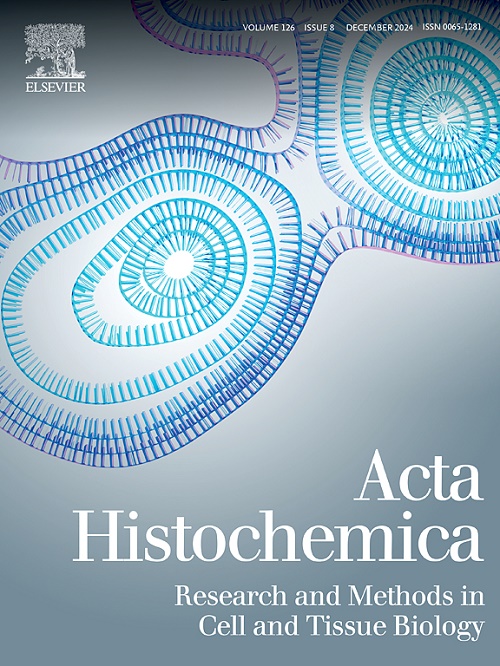Ultrastructure and immunohistochemistry of apteric skin in ratites and its epidermal soft cornification
IF 2.4
4区 生物学
Q4 CELL BIOLOGY
引用次数: 0
Abstract
An electron microscopy and immunohistochemistry study has been conducted to acquire comparative information on the structure of apteric skin in ratites, ostrich and emu. The epidermis is thin in the neck of both species and thicker in the dorsal region where acidic and neutral keratins are present in the viable epidermis and stratum corneum. The dermis in both species is mostly occupied by collagen fibrils that form large bundles, often organized in alternated layers in the deeper part of the dermis. Numerous collagen fibrils contact the basement membrane of the epidermis. Sparse tactile Meissner or Krause sensilli are present among the thick collagen bundles. The ostrich epidermis in the dorsal skin is thicker than in the neck, with a columnar basal layer, 3–5 intermediate suprabasal layers and a thick corneous layer. The epidermis of the neck in emu is very thin, featuring two-three narrow cell layers above a flat basal layer and a relatively thick corneous layer. Basal and suprabasal keratinocytes contain lipid droplets and small keratin bundles but no keratohyalin accumulates in pre-corneous cells. The thin corneocytes form a multilayered corneous layer. Loricrine is present in pre-corneous and corneous layers while CBPs, formerly indicated as beta-keratins, are absent in apteric epidermis.
大鼠皮肤的超微结构和免疫组织化学及其表皮软角化。
通过电子显微镜和免疫组织化学研究,我们获得了大鼠、鸵鸟和鸸鹋皮肤结构的比较信息。这两种动物颈部的表皮较薄,背部较厚,酸性和中性角蛋白存在于有活力的表皮和角质层中。两种动物的真皮层大部分被胶原纤维占据,胶原纤维形成大束,通常在真皮深层交替排列。许多胶原纤维与表皮的基底膜接触。在粗大的胶原纤维束中有稀疏的触觉梅斯纳(Meissner)或克劳斯(Krause)感觉器。鸵鸟背部表皮比颈部表皮厚,有一个柱状基底层、3-5个中间基底上层和一个厚角质层。鸸鹋颈部的表皮非常薄,在平坦的基底层和相对较厚的角质层上有两三层狭窄的细胞层。基底层和上基底层角质细胞含有脂滴和小的角质蛋白束,但角质层前细胞中不积聚角质纤维蛋白。薄角质细胞形成多层角质层。角质层前细胞和角质层中含有 Loricrine,而凋亡表皮层中则没有 CBPs(以前称为 beta-角蛋白)。
本文章由计算机程序翻译,如有差异,请以英文原文为准。
求助全文
约1分钟内获得全文
求助全文
来源期刊

Acta histochemica
生物-细胞生物学
CiteScore
4.60
自引率
4.00%
发文量
107
审稿时长
23 days
期刊介绍:
Acta histochemica, a journal of structural biochemistry of cells and tissues, publishes original research articles, short communications, reviews, letters to the editor, meeting reports and abstracts of meetings. The aim of the journal is to provide a forum for the cytochemical and histochemical research community in the life sciences, including cell biology, biotechnology, neurobiology, immunobiology, pathology, pharmacology, botany, zoology and environmental and toxicological research. The journal focuses on new developments in cytochemistry and histochemistry and their applications. Manuscripts reporting on studies of living cells and tissues are particularly welcome. Understanding the complexity of cells and tissues, i.e. their biocomplexity and biodiversity, is a major goal of the journal and reports on this topic are especially encouraged. Original research articles, short communications and reviews that report on new developments in cytochemistry and histochemistry are welcomed, especially when molecular biology is combined with the use of advanced microscopical techniques including image analysis and cytometry. Letters to the editor should comment or interpret previously published articles in the journal to trigger scientific discussions. Meeting reports are considered to be very important publications in the journal because they are excellent opportunities to present state-of-the-art overviews of fields in research where the developments are fast and hard to follow. Authors of meeting reports should consult the editors before writing a report. The editorial policy of the editors and the editorial board is rapid publication. Once a manuscript is received by one of the editors, an editorial decision about acceptance, revision or rejection will be taken within a month. It is the aim of the publishers to have a manuscript published within three months after the manuscript has been accepted
 求助内容:
求助内容: 应助结果提醒方式:
应助结果提醒方式:


